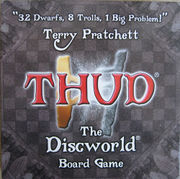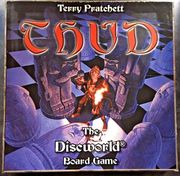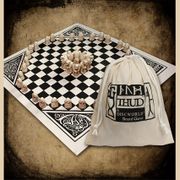Thud: Difference between revisions
Old Dickens (talk | contribs) m (more spaces) |
|||
| (13 intermediate revisions by 3 users not shown) | |||
| Line 1: | Line 1: | ||
[[File:ThudGameBox.jpg|right|180px|thumb|First Edition Box Art]] | |||
[[File:ThudGameBox2.jpg|right|180px|thumb|Second Edition Box Art]] | |||
[[File:ThudGameBox3.jpg|right|180px|thumb|[[Discworld Emporium]] Edition]] | |||
''If you were looking for the book, see'' {{T!}} | ''If you were looking for the book, see'' {{T!}} | ||
'''Thud''' is a board game based on the earlier dwarfish game of [[Hnaflbaflsniflwhifltafl]]. It is played mainly by | '''Thud''' is a board game based on the earlier dwarfish game of [[Hnaflbaflsniflwhifltafl]]. It is played mainly by [[Dwarfs]] and [[Trolls]], although it does have devoted human players as well. In a game of Thud, the Dwarfs' side has a natural advantage and will inevitably win against an unskilled player. A careful player can achieve victory for the Trolls, however. A match therefore consists of two games with the players alternating sides. According to [[Reacher Gilt]], a well-played game of Thud can reveal the weaknesses of one's opponent. According to [[Lord Vetinari]], the goal of the game should be to discover one's own weaknesses. [[Mr Shine]] hopes that encouraging Dwarfs and Trolls to play Thud will promote peace between the two by providing an outlet for replaying the [[Battle of Koom Valley]] in miniature - and ''bloodlessly''. Greater background information is given in "[[Short Story:Thud-A Historical Perspective|Thud - A Historical Perspective]]". | ||
The game itself echos the game played by Vikings and Anglo-Saxons " | The game itself echos the game played by Vikings and Anglo-Saxons "{{wp|Tafl games#Hnefatafl|Hnefatafl}}", which literally means "Kings Table". Hnefatafl echos go beyond just the name. Like 'Thud' it is unusual in that it is an 'asymmetrical' game - each side has different forces and different objectives (unlike, say, [[Stealth Chess|Chess]]). The defending side is trying to get the King to safety and escape on a corner square, while the besiegers/attackers are trying to either capture the king, or position their forces so his escape is impossible. Making Kings safe is of course a recurring theme in {{TFE}} and {{T!}}. | ||
The dwarven pieces on the 1st edition front cover echo the 'Lewis' chess set, often used as an inspiration for modern reproductions, as it is the only known set of a Dark Age board game. This, along with the game, reinforces the 'pop-viking' imagery Pratchett uses for dwarfs. | The dwarven pieces on the 1st edition front cover echo the 'Lewis' chess set, often used as an inspiration for modern reproductions, as it is the only known set of a Dark Age board game. This, along with the game, reinforces the 'pop-viking' imagery Pratchett uses for dwarfs. In 2002 (on [[Roundworld]]) the game Thud was created by Trevor Truran. | ||
==The Rules== | ==The Rules== | ||
| Line 14: | Line 17: | ||
*If a dwarf is next to a troll and it has not been captured, it can capture the troll. However, what mostly happens is that the dwarfs are arranged into a huddle, and the front dwarf is 'hurled' by the back one to capture the troll. The number of squares it can be hurled is dictated by the number of dwarfs in the line. Trolls can also do this. | *If a dwarf is next to a troll and it has not been captured, it can capture the troll. However, what mostly happens is that the dwarfs are arranged into a huddle, and the front dwarf is 'hurled' by the back one to capture the troll. The number of squares it can be hurled is dictated by the number of dwarfs in the line. Trolls can also do this. | ||
*The game ends when no more captures can be made. The pieces that still remain are given points- four points for an uncaptured troll and one for an uncaptured dwarf- and the players recommence, playing on the opposite side. The player with the most points wins. | *The game ends when no more captures can be made. The pieces that still remain are given points- four points for an uncaptured troll and one for an uncaptured dwarf- and the players recommence, playing on the opposite side. The player with the most points wins. | ||
There is also a another way that the game can be played called Koom Valley Thud, with new rules. | |||
==Appearances== | |||
* "[[Short Story:Thud-A Historical Perspective|Thud - A Historical Perspective]]" is an in-universe history of the game which was has been included with each edition of the game, and was also posted on the official Thud website. It was later collected in {{OMWF}} (as "The Story of Thud") and {{BS}}. | |||
* Thud first appears in the novels in {{GP}}; [[Reacher Gilt]] comments on the Patrician's antique board and pieces, which were a gift from the [[Low King]]. It is revealed that Vetinari plays a game remotely via [[Clacks]] with an old friend, implied to be Lady [[Margalotta]]. | |||
* According the Terry's notes for "Thud - A Historical Perspective" in {{BS}}, Thud gave him an idea which led to {{T!}}, where the game serves as an important plot device. Vimes does not play, to the surprise of many in the book, but learns the rules during the novel from the dwarf [[Bashfull Bashfullsson]]. The alternate "Koom Valley" rules and a "King's Game" setup are added in the second edition of the Roundworld game, which was released alongside the novel. | |||
* Mentioned in {{UA}}. | |||
* A pivotal game of Thud from {{T!}} is mentioned again in {{RS}}. | |||
==Annotation== | ==Annotation== | ||
19/12/12: an episode of popular archaeological show ''Time Team'' aired on British TV, in which an Anglo-Saxon game looking very much like Thud was briefly displayed and described. | 19/12/12: an episode of popular archaeological show ''Time Team'' aired on British TV, in which an Anglo-Saxon game looking very much like Thud was briefly displayed and described. | ||
==External Links== | |||
* [https://www.discworldemporium.com/games-activities/229-thud Thud] on the Discworld Emporium | |||
* [https://boardgamegeek.com/boardgame/4532/thud Thud] at boardgamegeek.com | |||
[[Category:Discworld Games]] | [[Category:Discworld Games|Thud]] | ||
[[Category:Games|Thud]] | |||
[[de:Klonk]] | [[de:Klonk]] | ||
Latest revision as of 00:49, 1 November 2022



If you were looking for the book, see Thud!
Thud is a board game based on the earlier dwarfish game of Hnaflbaflsniflwhifltafl. It is played mainly by Dwarfs and Trolls, although it does have devoted human players as well. In a game of Thud, the Dwarfs' side has a natural advantage and will inevitably win against an unskilled player. A careful player can achieve victory for the Trolls, however. A match therefore consists of two games with the players alternating sides. According to Reacher Gilt, a well-played game of Thud can reveal the weaknesses of one's opponent. According to Lord Vetinari, the goal of the game should be to discover one's own weaknesses. Mr Shine hopes that encouraging Dwarfs and Trolls to play Thud will promote peace between the two by providing an outlet for replaying the Battle of Koom Valley in miniature - and bloodlessly. Greater background information is given in "Thud - A Historical Perspective".
The game itself echos the game played by Vikings and Anglo-Saxons "Hnefatafl", which literally means "Kings Table". Hnefatafl echos go beyond just the name. Like 'Thud' it is unusual in that it is an 'asymmetrical' game - each side has different forces and different objectives (unlike, say, Chess). The defending side is trying to get the King to safety and escape on a corner square, while the besiegers/attackers are trying to either capture the king, or position their forces so his escape is impossible. Making Kings safe is of course a recurring theme in The Fifth Elephant and Thud!.
The dwarven pieces on the 1st edition front cover echo the 'Lewis' chess set, often used as an inspiration for modern reproductions, as it is the only known set of a Dark Age board game. This, along with the game, reinforces the 'pop-viking' imagery Pratchett uses for dwarfs. In 2002 (on Roundworld) the game Thud was created by Trevor Truran.
The Rules
- The thirty-two dwarfs are arranged around the edge of the octagonal board, while the eight trolls are placed around the Thud-stone in the middle. The dwarf side goes first.
- The dwarfs can go any number of squares in any direction, including diagonals. The trolls, however, can only move one square in any direction.
- If a troll moves into a space next to a dwarf it can capture it. It has to move, however- it cannot take it while standing still. It can take any number of dwarfs with one move.
- If a dwarf is next to a troll and it has not been captured, it can capture the troll. However, what mostly happens is that the dwarfs are arranged into a huddle, and the front dwarf is 'hurled' by the back one to capture the troll. The number of squares it can be hurled is dictated by the number of dwarfs in the line. Trolls can also do this.
- The game ends when no more captures can be made. The pieces that still remain are given points- four points for an uncaptured troll and one for an uncaptured dwarf- and the players recommence, playing on the opposite side. The player with the most points wins.
There is also a another way that the game can be played called Koom Valley Thud, with new rules.
Appearances
- "Thud - A Historical Perspective" is an in-universe history of the game which was has been included with each edition of the game, and was also posted on the official Thud website. It was later collected in Once More* *with Footnotes (as "The Story of Thud") and A Blink of the Screen.
- Thud first appears in the novels in Going Postal; Reacher Gilt comments on the Patrician's antique board and pieces, which were a gift from the Low King. It is revealed that Vetinari plays a game remotely via Clacks with an old friend, implied to be Lady Margalotta.
- According the Terry's notes for "Thud - A Historical Perspective" in A Blink of the Screen, Thud gave him an idea which led to Thud!, where the game serves as an important plot device. Vimes does not play, to the surprise of many in the book, but learns the rules during the novel from the dwarf Bashfull Bashfullsson. The alternate "Koom Valley" rules and a "King's Game" setup are added in the second edition of the Roundworld game, which was released alongside the novel.
- Mentioned in Unseen Academicals.
- A pivotal game of Thud from Thud! is mentioned again in Raising Steam.
Annotation
19/12/12: an episode of popular archaeological show Time Team aired on British TV, in which an Anglo-Saxon game looking very much like Thud was briefly displayed and described.